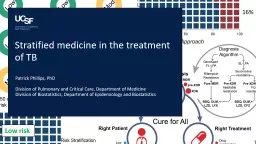

Patrick Phillips PhD Division of Pulmonary and Critical Care Department of Medicine Division of Biostatistics Department of Epidemiology and Biostatistics Treatment Stratification httpswwwmyabariscomtoolslifeexpectancycalculatorhowlongwillilive ID: 788806
Download The PPT/PDF document "Stratified medicine in the treatment of ..." is the property of its rightful owner. Permission is granted to download and print the materials on this web site for personal, non-commercial use only, and to display it on your personal computer provided you do not modify the materials and that you retain all copyright notices contained in the materials. By downloading content from our website, you accept the terms of this agreement.
Slide1
Stratified medicine in the treatment of TB
Patrick
Phillips, PhD
Division of Pulmonary and Critical
Care, Department of Medicine
Division of Biostatistics, Department of Epidemiology and Biostatistics
Slide2Treatment Stratification
https://www.myabaris.com/tools/life-expectancy-calculator-how-long-will-i-live/
2
Slide33
Personalized medicine:
“molecular profiling technologies for tailoring the right therapeutic strategy for the right person at the right time”.
Overambitious promise of individualized unique drug targeting and development.
Stratified medicine: reflects the effects of medicines at population level.
This population approach better aligns with the public health approach used in TB.
European Commission DR. Workshop report, Stratification biomarkers in
personalized
medicine,
2010
Slide4Bringing stratified medicine to TB –
a paradigm shift in trial design and overall objectives
4
Cure
all
patients with TBNot 90-95% of patients, but target cure >
99%
Identify a pragmatic treatment strategy that is
superior to
standard of care
Pursue
cure for all and keep markers simple.
Abandon “One Size Fits All” approach
Use baseline and/or
on-treatment
markers to stratify patients into risk groups
Patients in different risk groups receive different durations or compositions of regimens
Slide5Relapse rates in 2/3/4-month regimens in DS-TB
Daily SHRZ, Smear negative (Hong Kong, 1981, 1989)
Total
patients
NIRT
(
Jawahar
, 2013)
Gati
Moxi
OFLOTUB (Merle, 2014)
RIFAQUIN (Jindani, 2014)
REMoxTB
(Gillespie, 2014)
Moxi
& INH
Moxi
& EMB
(Johnson, 2009) Smear
neg
, no cavities
HR throughout,
with S&Z added
(Fox, 1981)
5
Slide6Relapse rates in 2/3/4-month regimens in DS-TB
Daily SHRZ, Smear negative (Hong Kong, 1981, 1989)
Total
patients
NIRT
(
Jawahar
, 2013)
Gati
Moxi
OFLOTUB (Merle, 2014)
RIFAQUIN (Jindani, 2014)
REMoxTB
(Gillespie, 2014)
Moxi
& INH
Moxi
& EMB
(Johnson, 2009) Smear
neg
, no cavities
HR throughout,
with S&Z added
(Fox, 1981)
Proportion of patients cured
6
Slide77
High risk
Moderate risk
Low risk
3%
8%
16%
6-month HRZE, 8%
unfavorable
2%
7%
20%
Shorter novel regimen ‘one size fits all’
8.7%
unfavorable
Evaluating the same shorter regimen for all
Non-inferiority depends primarily on efficacy in the high risk patients
Slide88
High risk
Moderate risk
Low risk
3%
8%
16%
6-month HRZE, 8%
unfavorable
2%
5%
5%
Novel regimen with treatment stratification, 3-4%
unfavorable
Evaluating a treatment stratification approach
Radically shorter duration
Shorter duration
Longer duration
Slide99
High risk
Moderate risk
Low risk
3%
8%
16%
6-month HRZE, 8%
unfavorable
2%
5%
5%
Novel regimen with treatment stratification, 3-4%
unfavorable
Evaluating a treatment stratification approach
Radically shorter duration
Shorter duration
Longer duration
1. Target
Treatment Shortening
, with no reduction in efficacy in low risk group
2. Target
Improved Efficacy
, with a more potent regimen in high risk group
Slide10The CURE-TB Strategy – Stratified Medicine to Cure All in DS TB
Illustrative example using RPT at
1200mg
10
Strata (risk of relapse)
Control
Treatment strategy 1
(Baseline factors only)
Treatment
s
trategy 2
(On
treatment biomarker to adjust duration
)
Low
2HRZE/4HR
(6 months)
2H
P
ZE
(2
months)
2H
P
ZE
(2+
months)Moderate2HRZE/4HR
(6 months)
2HPZE/2HP
(4 months)2HPZE/2H
P(4+
months)
High
2HRZE/4HR
(6 months)
2H
P
ZE/4H
P
(6
months)
2H
P
ZE/4H
P
(6+ months
)
Randomise
Low risk of relapse
Moderate risk of relapse
High risk of relapse
From the TBTC CURE-TB Working Group
Slide11Advantages of stratified medicine in TB
Each patient receives the therapy that gives them the best opportunity for cure
Phase III trials with superiority rather than non-inferiority designs.
Superiority more robust for interpretation and
generalizabilityTwo-pronged attack to achieve cure for allShorter duration for those for which it is appropriate
Reducing health system costs, improving adherenceLonger duration for those that need itImproving population-level outcomes, reducing onward transmission
11
Slide12Objections to stratified medicine in TB
We don’t have good enough stratification factors
TB-REFLECT analysis is providing robust evidence
Stratification algorithm can evolve over time as new data and markers emerge
Treatment stratification will lead to market fragmentationInformal stratification is already practiced in many resource-rich settingsFormalization
of an evidence-based treatment strategy allows for clear strategies for market access.It’s too complex to implement in a resource poor settingBegin with simple markers
Utilize
readily available digital technology for stratification
12
Slide13Acknowledgements
Payam Nahid, Rada Savic, and the TBTC CURE TB Working Group
The CURE TB MDR-TB Consortium
13